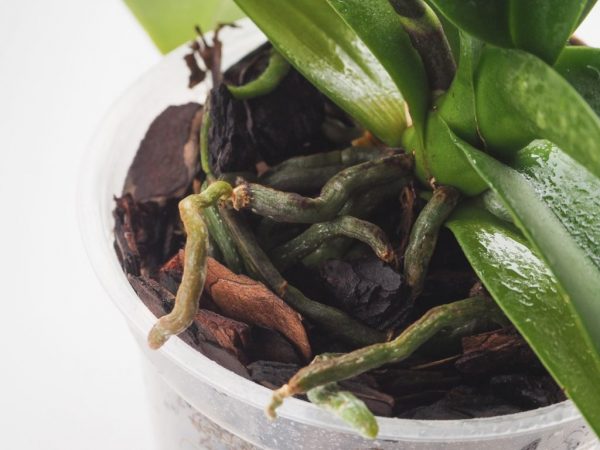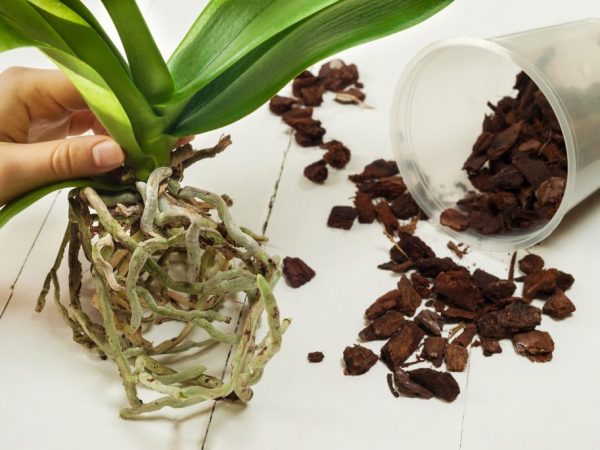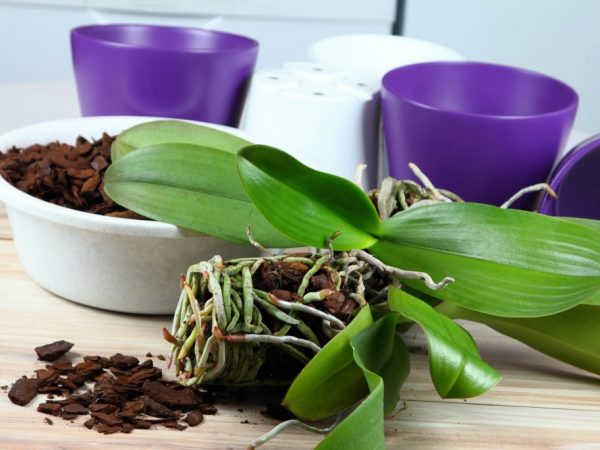Soil for orchids
Good quality soil for orchids is the basis of their health and the guarantee of abundant flowering. Epiphytes are whimsical plants, and a lot also depends on the substrate. That is why, before transplanting phalaenopsis, it will be necessary to prepare the land of the best composition with the necessary number of elements that will suit them.

Soil for orchids
Soil composition
Many growers are interested in whether ordinary soil is suitable for orchids. The soil for the orchid is different from all other soil mixtures. Epiphytes cannot be planted on ordinary soil. They will have to find a substrate that is ideal for a plant with an unusual growing pattern. The required soil composition for orchids includes:
- wood ash;
- sod or roots of forest ferns;
- sphagnum;
- bark of trees.
The composition of the soil for orchids varies depending on the variety and type of plants, but the listed Biocomponents cannot be changed for anything. Also, the land for epiphytes consists of:
- coconut fiber;
- peat;
- perlite;
- vermiculite;
- crushed expanded clay or other small stones;
- valves of spruce and pine cones;
- nut husks.
The soil mixture for growing epiphytes called Dendrobium nobile also includes soil soil and humus of leaves of garden trees. The soft ground is good for germinating phalaenopsis seeds. Such a substrate often contains peat, so the soil of this composition is also ideal for planting plants.
Substrate requirements

Peculiar roots
The root system of epiphytes has no analogues, because its ability to consume moisture from the air or absorb it from a wet filler is not given to other representatives of the plant world. That is why the substrate should be:
- loose
- water-permeable and moisture-consuming;
- easy;
- neutral in acidity (pH 5.5-6.0).
Choose the Components of the soil mixture from among non-toxic and long-term decomposing. Such a blank is suitable for planting and growing epiphytes of most varieties and any other indoor flowers, for example, anthurium.
In the case when it is necessary to plant cymbidium and pafiopedilum, the soil is prepared differently. The care of these flowering plants is different from the cultivation of other epiphytes. The soil mixture will also differ, in which bark and coal will prevail.
Homemade soil mixtures can also include:
- pumice;
- bark of a cork tree;
- gravel.
All these substances are used as drainage. They will need to be treated with dry heat, and during storage, protected from sources of mold and temperature extremes. Before the procedure for roasting stones and bark, all components are soaked in a solution of potassium permanganate and kept in it for 24 hours.
Selection of substrate
Ready-made soil for orchids is bought in specialized stores. Orchid soil has a complex composition. The ideal substrate can be purchased under the brand names:
- Ecoflora;
- Orchiata;
- Fiasco;
- Pokon;
- Kekkila;
- Compo;
- Sana;
- Fasco;
- Gardens of Babylon;
- Queen;
- Florica;
- Effect-Bio;
- Seramis $
- Weltorf.
Recently, a premium coconut substrate called coco has become very popular. This type of land loves most varieties of epiphytes. Soil of this type is sold in tablets, washers, briquettes and in bulk. It needs to be poured into pots in its pure form or made part of a complex soil.
Also, aqua soil is used as a basis for growing epiphytes. It is a hydrogel bead. Such an artificial composition has no nutritional value, but it allows you to retain a large amount of moisture, and then help the plant to consume it in a measured way.
It is not difficult to acquire soil, because its cost is low, but many breeders prefer to prepare soil for orchids with their own hands.
A good nutritious soil for all types of orchids is easy to prepare yourself. You should use blanks assembled with your own hands or purchased in florist shops. A self-made soil mixture at home, subject to the rules and proportions, will not differ from the purchased options.
Sanitization

We wash the roots of the orchid
Before using any of the substrates, a sanitary preparation is required. The most correct way to process the substrate is:
- the washing up;
- heat treatment (roasting in the oven or boiling);
- easy drying;
- grinding.
The bark for the substrate is taken only from non-living trees, and then treated with an antiseptic. The moss is soaked in salt water for a day, after which it is rinsed and dried. The shells of nuts, cones and coconut threads are treated with boiling water.
Precisely such actions will have to be performed in the case when the soil:
- turned green;
- got too wet;
- covered with a white coating from hard water.
Homemade recipe
Preparing soil for epiphytes at home does not take much time. Step-by-step instructions for obtaining a soil mixture of a standard composition:
- Initially, the components of the mixture are calcined and dried: pine bark, ash, moss, fern roots.
- All of the listed components of the mixture are taken in equal proportions and mixed in a deep bowl. Mineral leavening agents (vermiculite, perlite) are put in not more than a third of the total mass of the substrate.
- The prepared container is filled with soil, but first drainage holes are made in a plastic transparent pot with a red-hot metal object and a thick layer of expanded clay or coconut fiber is placed on the bottom.
The best mixture for preparing the substrate:
- 5 parts of bark,
- 1 part charcoal;
- 2 parts of moss.
All other components that have nutritional value are taken in equal proportions, but their total weight should be about half of the available basic composition.
Storage of soil mixture
The finished substrate is subjected to final drying, after which it is packed in paper bags or rag bags and tightly packed. Each component must be prepared in a different container. Store all the components of soil mixtures separately from each other in a well-ventilated area. The soil should be prepared just before planting the plants.
The substrate should be reliably protected from heat and cold, as well as direct sunlight. The most unpretentious to all changes is a coconut product, because its fibers do not absorb moisture, are not afraid of heat and have a long decay period.
Soil for orchids should be:
- dry;
- without smell;
- crumbly.
If the substrate does not meet these criteria, then the ambulance in such cases consists in processing the components with antibacterial compounds of chemical origin. Substrate of inadequate quality must be disposed of. An exception may be expanded clay, which can be heated and dried.
The use of a poor-quality substrate threatens the development of pathogenic flora and the death of the plant. Also, a soil mixture that does not fit the flower in composition is often the reason for the absence of epiphyte flowering.
Conclusion
Many shops specializing in floriculture sell ready-made soil for orchids, which is also suitable for spathiphyllum (another name for "female happiness"). But even the best substrate turns out to be unsuitable for some epiphytes due to their mode of life and developmental characteristics. A loose soil mixture is needed for seeds and plants that have undergone diseases.
It is not difficult to prepare soil for an orchid with your own hands. To do this, it is worthwhile to strictly observe the proportions and be sure to make sure of the quality and safety of all components used.


